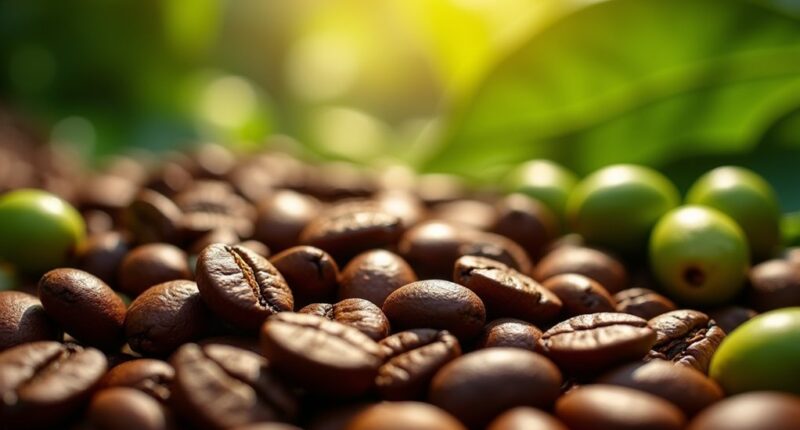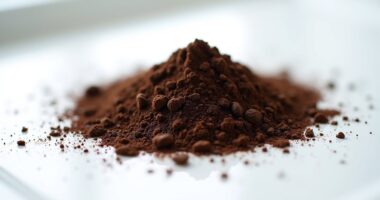So, coffee beans are made up of a bunch of cool stuff! You’ve got proteins, about 9-13%, which help flavor pop after roasting. Then there are carbs, making up around 60%, that give your brew a sweet kick. Don’t forget lipids, those 7-17% help with flavor and creamy texture. Plus, a mix of acids and minerals adds even more magic. It’s kinda like a science experiment in your cup, and there’s more to discover about this tasty brew!
At a Glance
- Coffee beans are composed of 9–13% protein, with green beans containing 11–15% protein, affecting flavor during roasting.
- Approximately 60% of a coffee bean’s weight is carbohydrates, including cellulose, hemicellulose, and sucrose, influencing sweetness and mouthfeel.
- Lipids make up 7% to 17% of coffee beans and are essential for flavor, texture, and foam stability during brewing.
- The chemical composition includes various acids and sugars that contribute to the unique flavor profile of coffee.
- The Maillard reaction during roasting enhances aromas and flavors, while brewing methods impact extraction and overall taste experience.
Chemical Composition of Coffee Beans
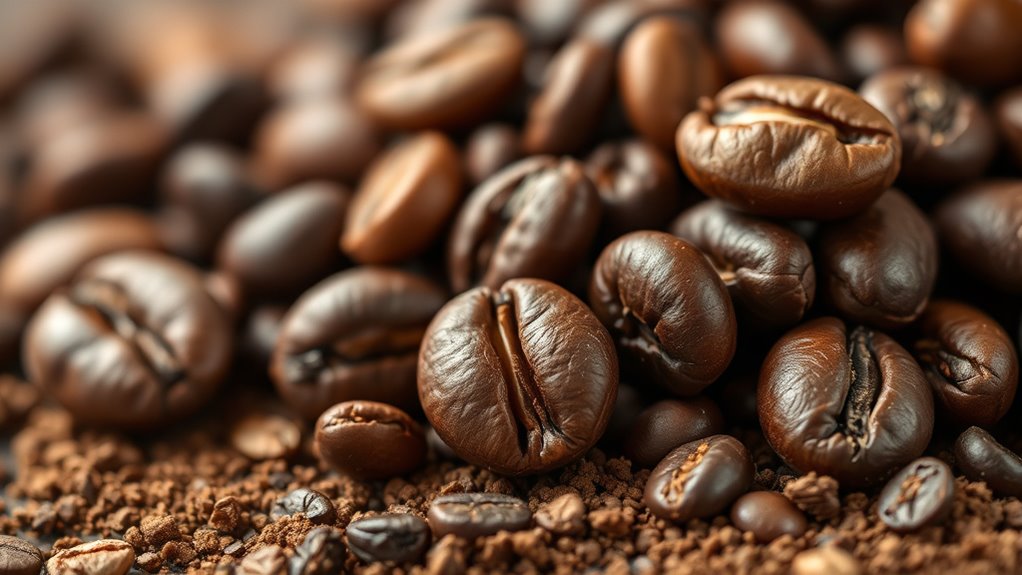
When you take a sip of your favorite coffee, have you ever wondered what makes those little beans so special?
It’s the magic of amino acids and proteins! Each green coffee bean has about 9–13% protein, depending on where it’s grown. These proteins, along with amino acids, transform during roasting, creating those rich flavors we crave. Isn’t that cool? Additionally, the process of savoring the rich flavors during brewing enhances the overall coffee experience.
Plus, there’s some protein variability based on the coffee species and farming practices. So, every cup you enjoy reflects a unique story of its origin.
Next time you sip, remember the science behind that delicious aroma and flavor!
Carbohydrates in Coffee
Let’s explore the world of carbohydrates in coffee—did you know that about 60% of a coffee bean’s weight is made up of these little guys? When you brew, the sugar breakdown and fiber extraction change how your coffee tastes. Here’s a quick look at the carbohydrate types in coffee:
| Type | Percentage in Raw Beans | Role in Coffee |
|---|---|---|
| Cellulose | 18% | Structural support |
| Hemicellulose | 15% | Texture and mouthfeel |
| Sucrose | 7% | Sweetness precursor |
| Starch | 10% | Flavor enhancer |
The carbohydrates in coffee play a crucial role in contributing to the overall flavor profile of your brew, influencing everything from sweetness to body.
Proteins and Their Importance
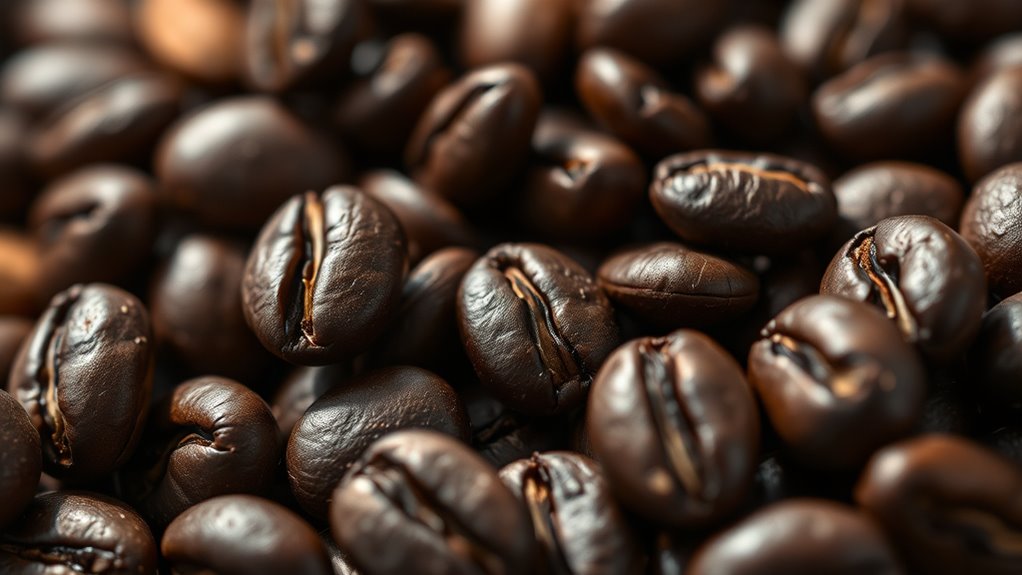
Ever wondered what’s hiding in your cup of joe besides caffeine?
Well, coffee beans actually pack a protein punch! With about 11–15% protein in green beans, they’re one of those surprising protein sources.
Even though roasting reduces protein a bit, essential amino acids stick around. You won’t get much protein from your brewed coffee, though—most of it stays in the grounds.
But if you mix in milk for a latte, boom! You’ve boosted your protein game. Additionally, storing your coffee beans properly can help maintain their nutritional quality and freshness over time.
The Role of Lipids in Coffee Flavor
You might think caffeine is the star of the coffee show, but lipids are the unsung heroes that add a whole lot of flavor.
These little guys, making up 7% to 17% of coffee beans, help create that rich aroma we all love. Lipid profiles in different beans, like Arabica and Robusta, shape their unique tastes, too!
They stabilize foam during brewing, giving your coffee that creamy texture. Plus, they transform during roasting, enhancing flavor and mouthfeel. Discover the finest coffee beans at Walmart, where you can find a variety of options that showcase these flavor-enhancing lipids.
Caffeine: The Natural Stimulant
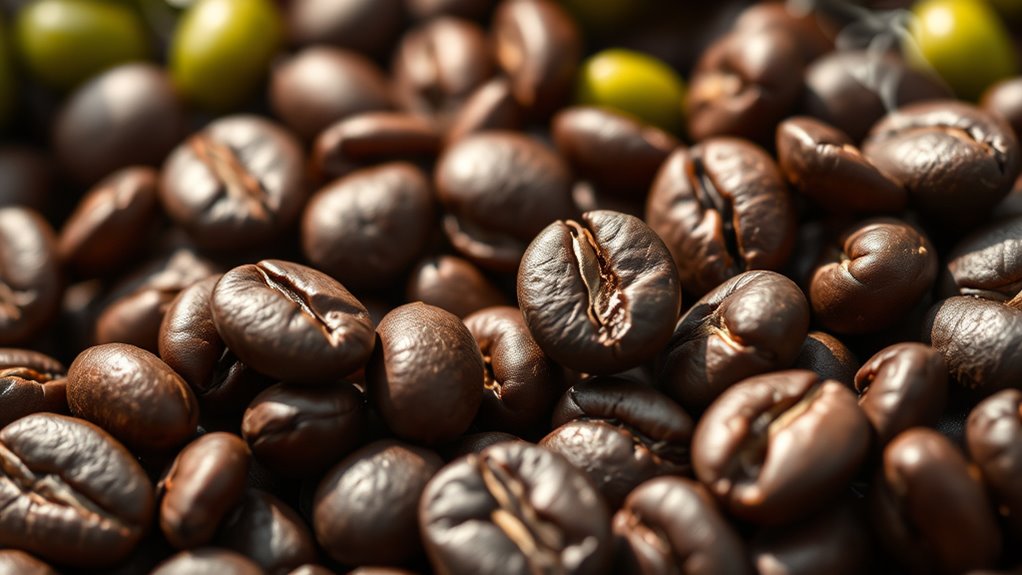
Caffeine, that magical little compound in your cup of coffee, is what gets many of us out of bed and ready to tackle the day.
It’s not just about waking up, though; it’s about the buzz!
Here are some fun caffeine facts:
- Caffeine Sources: Coffee beans, tea leaves, and chocolate are popular picks.
- Caffeine Effects: It boosts alertness and metabolism, making you feel alive!
- Brew Matters: Espresso packs more caffeine per ounce than brewed coffee.
- Daily Limits: Up to 400 mg a day is considered safe.
Additionally, instant coffee varieties often contain caffeine levels comparable to regular coffee, making them an excellent choice for a quick pick-me-up.
Minerals and Ash Content
When you sip your favorite cup of coffee, it’s not just the caffeine that gets you buzzing; the minerals packed inside those little beans play their part too!
Coffee’s loaded with potassium, calcium, and magnesium, which help create that delicious flavor we crave. Through ash analysis, we can see how these minerals affect everything from sweetness to acidity.
Coffee is rich in potassium, calcium, and magnesium, enhancing its flavor and influencing sweetness and acidity.
Plus, mineral absorption during brewing makes each cup unique. Additionally, low-acid coffee blends can enhance the overall enjoyment of coffee by minimizing discomfort while still delivering rich flavors. So, next time you enjoy your coffee, remember, those minerals are working hard behind the scenes, helping craft that perfect sip.
Cheers to your daily dose of not just caffeine, but mineral goodness too!
Organic Compounds Found in Coffee
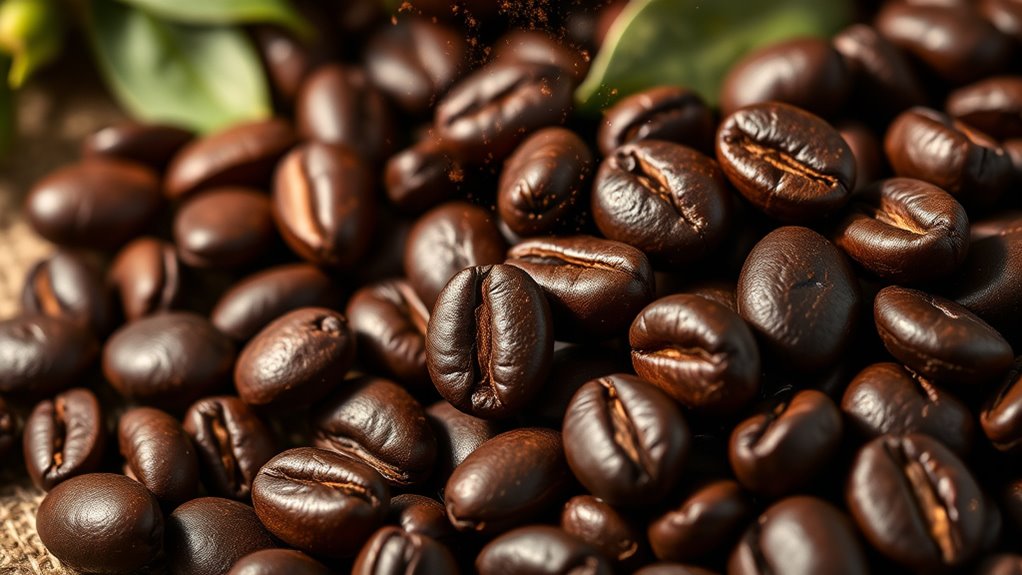
Coffee beans aren’t just little brown nuggets of joy; they’re packed with a bunch of organic compounds that make your morning brew so special!
These compounds contribute to the flavor, aroma, and overall experience. Here’s what you’ll find in your cup:
- Volatile Compounds: Like aldehydes and ketones, they give that irresistible aroma.
- Organic Acids: Citric and malic acids add a zing to the taste.
- Thiazoles: Antioxidant-rich, they come to life during roasting.
- Caffeine: The ultimate pick-me-up, keeping you energized!
Additionally, the right Nespresso capsules can enhance the unique flavors derived from these organic compounds.
Bioactive Compounds and Their Health Benefits
There’s more to coffee than just that delicious aroma wafting through your kitchen!
Those beans pack a punch with bioactive benefits that can boost your health. Caffeine helps you stay alert and can even fight off certain cancers—who knew your morning cup could be so powerful?
Plus, chlorogenic acids act like tiny superheroes with their antioxidant properties, fighting oxidative stress and promoting heart health.
And let’s not forget trigonelline, which can help keep kidney stones at bay. Additionally, Colombian coffee beans are known for their unique flavor profiles that enhance the overall coffee experience.
Structural Components of Coffee Beans
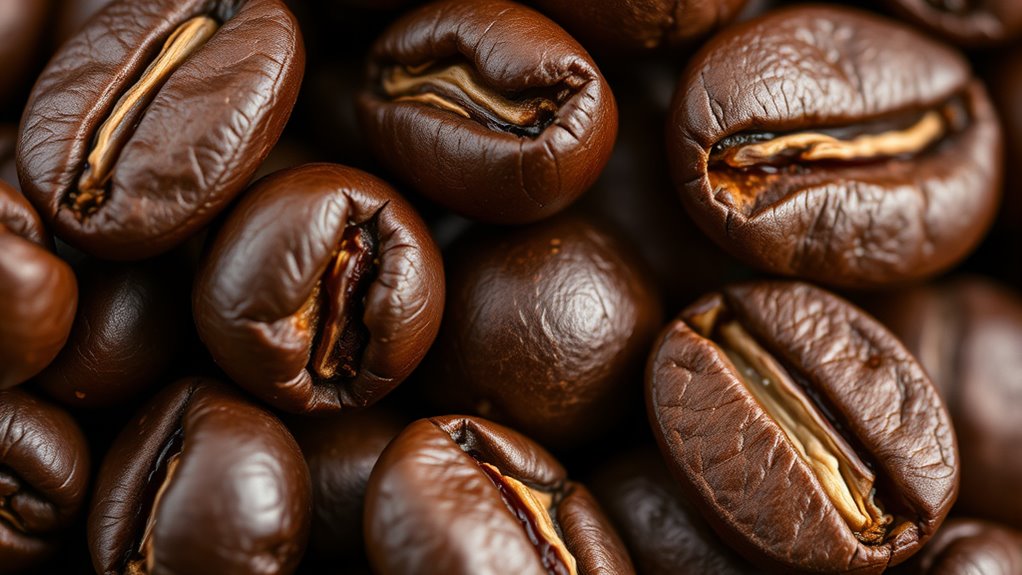
If you’ve ever wondered what’s hiding inside that little coffee bean, you’re in for a treat!
The seed structure of coffee beans is pretty cool and has several parts that work together. Here’s the scoop:
The fascinating structure of coffee beans features layers that collaborate to protect and nourish the seed inside!
- Exocarp: This outer layer protects against pests—like nature’s own shield!
- Mesocarp: The tasty flesh that adds sweetness during processing.
- Endocarp: The tough layer that forms a cozy home around the seed.
- Seed: It’s packed with nutrients, ready to sprout into a new plant. Additionally, the way coffee beans are stored can greatly affect their freshness and flavor, making coffee storage containers an essential factor for coffee enthusiasts.
Effects of Roasting on Coffee Composition
When you roast those little coffee beans, magic happens! You start with green beans, and as they heat up, they transform into aromatic wonders.
Different roasting profiles reveal unique flavor development; think nutty, floral, and fruity notes. The Maillard reaction kicks in, creating those delightful smells we crave.
Sure, some acids vanish, but others, like acetic acid, pop up, adding a zing! And let’s not forget about the sweetness from caramelized sugars—yum! The coarse grind of the beans is crucial in brewing methods like the French press, enhancing the overall flavor experience.
